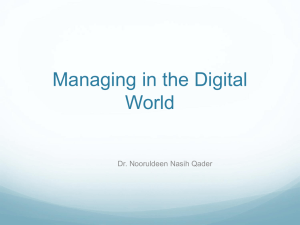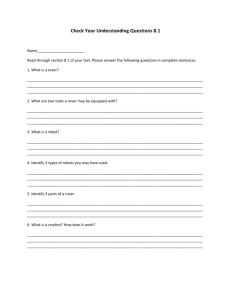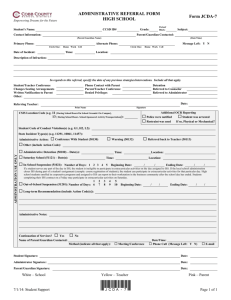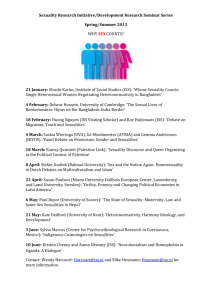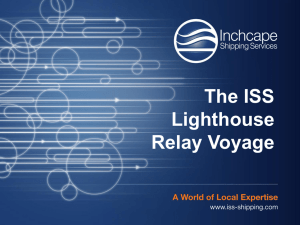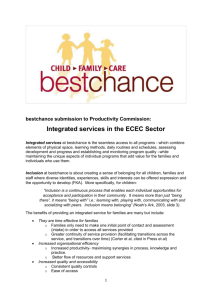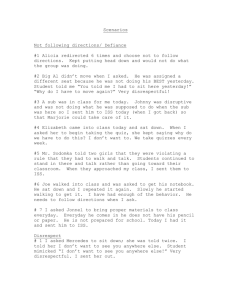Living on ISS
advertisement
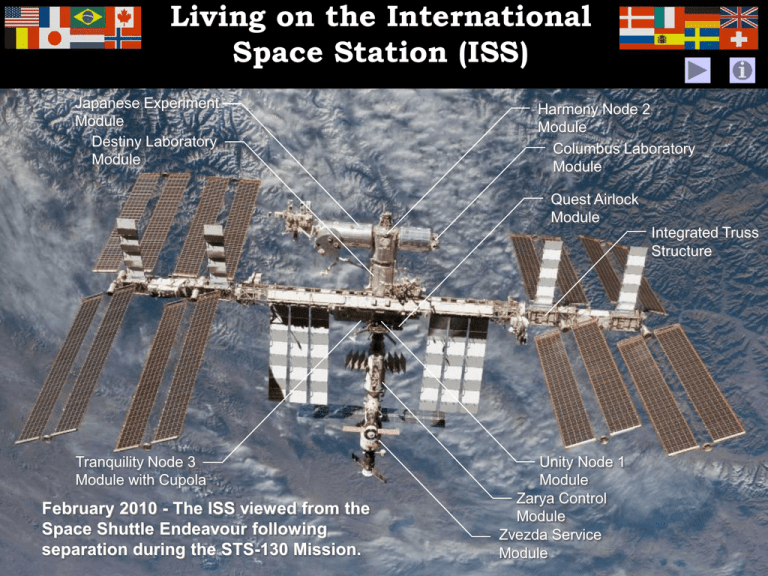
Living on the International Space Station (ISS) Japanese Experiment Module Destiny Laboratory Module Harmony Node 2 Module Columbus Laboratory Module Quest Airlock Module Integrated Truss Structure Tranquility Node 3 Module with Cupola February 2010 - The ISS viewed from the Space Shuttle Endeavour following separation during the STS-130 Mission. Unity Node 1 Module Zarya Control Module Zvezda Service Module Living on the International Space Station Food, Hygiene and Sleeping Working in Space Working Inside Select Image Having Fun Reference Information ISS Expedition Two Hosts Shuttle Astronauts July 2001 - Cosmonaut Yury V. Usachev organizes different kinds of food in the Zvezda Service Module at the galley. Expedition Two is hosting the STS-104 astronauts. Crew Compartment Toilet & Hygiene Compartment Galley Table ISS Expedition Two and STS-105 Crews Share a Meal August 2001 – During the first meal shared by the STS-105 and Expedition Two crews, the mission shirts were issued to the departing station occupants in the Zvezda Service Module. ISS Expedition Seven Crew Members Prepare Food October 2002 - Astronaut Peggy A. Whitson and cosmonaut Sergei Y. Treschev share a meal in the Zvezda Service Module. ISS Expedition Seven Crewmembers Eat a Meal June 2003 - Cosmonaut Yuri I. Malenchenko (right) and astronaut Edward T. Lu share a meal at the galley in the Zvezda Service Module. ISS Expedition Two Crewmember Shaves March 2001 – Cosmonaut Yury V. Usachev uses an electric razor in the Zvezda Service Module. A sleeping bag is located in the compartment behind the Cosmonaut. Astronaut Brushes Hair August 2007 - Astronaut Tracy Caldwell, on the mid deck of the Space Shuttle Endeavour, grooms her hair as she prepares to participate in the ISS supply transfer chores. ISS Expedition Five Astronaut gets Hair Cut October 2002 - Cosmonaut Valery G. Korzun cuts astronaut Peggy A. Whitson’s hair in the Zvezda Service Module. Peggy holds a vacuum device the crew has fashioned to collect freshly cut hair, which is floating freely. ISS Expedition Sixteen Astronaut Prepares to Sleep November 2007 - Astronaut Daniel Tani is tucked away in a sleeping bag near two Extravehicular Mobility Unit spacesuits in the Quest Airlock. ISS Expedition Six Cosmonaut Photographs Earth March 2003 - Cosmonaut Nikolai M. Budarin uses a still camera to photograph the topography of a point on Earth from a window in the Zvezda Service Module. ISS Expedition Four Cosmonaut takes Inventory March 2002 - Cosmonaut Yury I. Onufrienko catalogs water canisters in the Zvezda Service Module. ISS Expedition Six Cosmonaut Works in Zvezda Sleep Station March 2003 - Cosmonaut Nikolai M. Budarin uses a computer in a sleep station in the Zvezda Service Module. ISS Expedition Two Astronaut Installs Video Camera June 2001 - Astronaut Susan J. Helms mounts a video camera onto a bracket in the Zarya Control Module. Astronauts Operate SSRMS Arm March 2002 - Astronaut Daniel W. Bursch works the Space Station Remote Manipulator System (SSRMS) or Canadarm2 arm at the workstation in the Destiny laboratory. July 2006 - Astronaut Stephanie D. Wilson works with the Mobile Service System (MSS) and Canadarm2 controls in the Destiny laboratory. ISS Expedition Three Astronaut works Experiment August 2001 - Astronaut Frank L. Culbertson, Jr. works at the Biotechnology Specimen Temperature Controller (BSTC) for the Cellular Biotechnology Operations Support System (CBOSS) in the Destiny laboratory. Astronaut Examines Plant Growth Experiment November 2002 - Belgian Soyuz 5 Flight Engineer Frank DeWinne is pictured near a plant growth experiment in the Zvezda Service Module. DeWinne represents the European Space Agency. ISS Expedition Nine Crewmen with Russian Spacesuits August 2004 - Cosmonaut Gennady I. Padalka (left) and astronaut Edward M. (Mike) Fincke pose with their Russian Orlan spacesuits in the Pirs Docking Compartment. ISS Expedition Seven Astronaut Performs Maintenance September 2003 - Astronaut Edward T. Lu performs routine maintenance on an Extravehicular Mobility Unit (EMU) space suit in the Quest Airlock module. The work represents a mid-term checkout and included emptying and refilling the suit’s water tank and loops, cycling relief valves, checking sensors and collecting data, a leak check and running the suit’s fan for two hours to lubricate it. ISS Astronaut takes Photograph from Cupola Bay Window February 2010 - Japan Aerospace Exploration Agency astronaut Soichi Noguchi photographs the Earth from inside the newlyinstalled Cupola observation module. ISS Expedition Seven Astronaut Prepares to Work in Space October 2002 - Astronaut Piers J. Sellers exits the Quest Airlock module beginning the first scheduled session of extravehicular activity (EVA) for the STS-112 mission astronauts. Astronaut David A. Wolf (out of frame) joined Sellers on the spacewalk. Astronauts work on the Truss December 2006 - Astronaut Robert L. Curbeam Jr. (left) and European Space Agency astronaut Christer Fuglesang work on the Port 1 (P1) truss. The Pacific Ocean with New Zealand and Cook Strait is seen. Cook Strait divides New Zealand's North and South Islands. Astronauts Continue Truss Construction and Maintenance August 2007 - Astronauts Rick Mastracchio (right) and Clay Anderson continue construction and maintenance on the Port 1 (P1) truss. The S-Band Antenna Sub-Assembly is relocated from P6 to P1 truss, a new transponder is installed on P1, and a transponder is retrieved from P6. ISS Expedition Five Astronaut has Fun November 2002 - Astronaut Peggy A. Whitson floats in the Destiny laboratory. ISS Expedition Two Astronaut and Cosmonaut take Break April 2001 - Astronaut Susan J. Helms pauses from her work while cosmonaut Yury V. Usachev speaks into a microphone aboard the Destiny laboratory. ISS Expedition Two Astronaut Exercises April 2001 – Astronaut James S. Voss reads the book "The Last of the Mohicans" while exercising on the cycle ergometer in the Zvezda Service Module. In micro-gravity, the body loses bone and muscle mass. To counter these losses, crew members exercise daily. The Zvezda Service Module is equipped with a treadmill and a stationary bicycle. Crew members must strap themselves onto these devices to prevent them from floating away while exercising. ISS Expedition Three Cosmonaut plays Basketball October 2001 - Cosmonaut Vladimir N. Dezhurov takes a break from his duties, as he plays with a miniature basketball and net in the Unity Module. ISS Expedition Three Astronaut takes a Musical Break September 2001 - Astronaut Frank L. Culbertson, Jr. takes a brief timeout from a busy day to play his trumpet in the Quest Airlock module. ISS Expedition Three Cosmonaut Plays Guitar August 2001 - Cosmonaut Mikhail Tyurin of Rosaviakosmos relaxes among stowage bags in the hatch area of the Quest Airlock module. ISS Expedition Eight Crewmembers with Holiday Decorations December 2003 - Astronaut C. Michael Foale (left) and cosmonaut Alexander Y. Kaleri pose with holiday decorations in the Zvezda Service Module. Reference Information Creating the International Space Station by David Harland and John Catchpole, Pravis Publishing, 2002 - Comprehensive ISS history and technical information. Bay Window by Frank Morring, Jr; Aviation Week and Space Technology; February 22, 2010; Volume 172, page 33 - Description of the Cupola observation module. ISS images: http://spaceflight.nasa.gov/gallery/ http://commons.wikimedia.org/wiki/File:Russian_space_toilet.JPG General Information: http://spaceflight.nasa.gov/station/isstodate.html Space food, sleep, clothing, hygiene, work and fun: http://spaceflight.nasa.gov/living/index.html http://www.esa.int/esaHS/SEMHOB9ATME_business_0.html http://www.esa.int/SPECIALS/node3/SEM1XBSJR4G_0.html ISS modules and other components: http://www.nasa.gov/mission_pages/station/structure/index.html US modules’ environmental control and life support systems: http://www.boeing.com/defense-space/space/spacestation/systems/eclss.html ISS science experiments http://www.nasa.gov/mission_pages/station/science/experiments/BSTC.html http://www.nasa.gov/missions/science/f_lada.html ISS General Information (as of 11-27-09) ISS Flights American: 31 Space Shuttle flights Russian: 2 Proton launch vehicle flights 20 Soyuz crew flights 2 Soyuz assembly flight 35 Progress resupply flights European: 1 Automated Transfer Vehicle flight Japanese: 1 H-II Transfer Vehicle flight ISS Characteristics Orbit: 247 statute miles altitude; 17,000 miles per hour speed; 51.6 degree inclination above and below the equator Weight: 759,222 lbs (380 tons) Dimension: Width: 240 ft across solar arrays Spacewalks Space Shuttle-based: 28 spacewalks ISS-based: 108 spacewalks Total time: over 849 hours (35.4 days) Crew Support In flight: 6 crew members Ground: more than 100,000 personnel States: 37 Countries: 16 Zvezda Service Module The Russian Zvezda (Russian for Star) module is similar in design to the Mir Space Station Core Module. Crew member living accommodations are provided on Zvezda including personal sleeping quarters; hygiene and toilet facilities; a galley with a refrigerator/freezer, hot and cold water dispensers, hot plates to warm food, and a table for securing meals while eating. The 42,000 lb, 43 ft long module has a total of 14 windows, including three 9-inch diameter windows in the forward Transfer Compartment for viewing docking activities; one large 16inch diameter window in the Working Compartment; an individual window in the two sleep stations (crew compartment); and additional windows positioned for Earth and intra-module observations. Exercise equipment include a NASAprovided treadmill and a stationary bicycle. ISS Food The food on the ISS is mainly frozen, dehydrated or heat-stabilized, and drinks are dehydrated. Crew members collect food trays and utensils, locate their individually-packaged meals from a storage compartment, prepare the items (rehydrate if necessary), heat the items, place them in the tray and eat. Canned foods, can openers and eating utensils are among the items observed on or near the galley table. After the meal, they place the used items in a trash compactor, and clean and stow the utensils and trays. Interestingly, crew members select their menus approximately five months before their flight. MIR Human Waste Disposal Unit The Zvezda toilet is the same well-tested design used on the Russian Mir Space Station. The Mir female toilet configuration is shown. It physically resembles those used on Earth. The Waste and Hygiene Compartment (WHC) is the second toilet facility on the ISS. The WHC is an upgraded Mir toilet housed in an equipment rack and located in the American Tranquility module. Credit: Technik Museum Speyer, Germany Crew members must clamp themselves to the toilet in order not to float away. The crew uses individual urine funnels which are attached to hoses, and the urine is deposited into a waste container. Since there is almost no gravity, vacuum suction draws away the waste. Liquids and solids are treated separately and stored in cylindrical containers; both are disposed of when a Russian Progress cargo ship departs and burns up in the atmosphere. ISS Clothing ISS crews choose the shirts, shorts and pants they wear in space months before launch. Their clothes arrive at the station on a Progress re-supply vehicle or a space shuttle. Crews can choose Russian or U.S. clothing supplies. They can order heavy or light-duty Russian coveralls for work. Crew members do not change clothes as often in space as on Earth because taking supplies to the ISS is expensive and they do not get as dirty as on Earth. Crew members get one pair of shorts and a T-shirt for every three days of exercising. Their work shirts and pants/shorts are changed about once every 10 days. Generally, they get a new T-shirt to wear under their work shirts every 10 days. Underwear and socks are changed every other day. PolartecTM socks, worn if their feet get cold, must last a month. Each crew member also gets two sweaters, a pair of running shoes to use on the treadmill and another pair of shoes to wear when using the exercise bicycle. The pants they wear are covered with plenty of pockets and velcro. The pockets and velcro help them keep everything they're working with near them, otherwise it will float away. When a piece of clothing has been worn as many times as possible, it is placed in a bag for disposal. Clothes are not washed to save water. Very little clothing is brought back to Earth. Most of the worn clothing is placed in the Progress resupply vehicle before it undocks. The dirty clothing and other trash then burns up with the Progress when it re-enters the Earth's atmosphere. ISS Personal Hygiene Each crew member has a personal hygiene kit with a toothbrush, toothpaste, shampoo, razor and other basic toiletries. Whereas, the previous stations, Skylab and Mir, were equipped with a shower, the ISS crew members take sponge baths using washcloths or moistened towelettes to reduce the amount of water consumed. Simple tasks like brushing your teeth can be challenging in a micro-gravity environment. A little water doesn’t trickle in a stream - it suspends in a bubble! Quest Joint Airlock Module The 13,000 lb, 18.5 ft long American airlock is used to support Extravehicular Activity (EVA) by astronauts and cosmonauts. The airlock is mounted to the Unity module starboard Common Berthing Mechanism. It has two sections. The large 13.1 ft diameter section is where the crew can pre-breathe oxygen, don and doff their spacesuits as well as store the spacesuits and their EVA equipment. The smaller section is used to egress and ingress through the airlock hatch. Sleeping on the ISS Sleeping on the station is quite different from sleeping on Earth. Instead of beds, crew members sleep in wall-mounted sleeping bags they slip into and zip up. The bags are equipped with arm restraints to prevent crew members’ arms from floating above their heads while they sleep. Sleeping bags are located in two compartments in the Zvezda and Destiny modules and throughout the interior of the ISS. Generally, crew members are scheduled for a little more than eight hours of sleep at the end of each mission day. They may wake up in the middle of their sleep period to use the toilet, or stay up late and look out the window. They have reported having dreams and nightmares, and some have reported snoring. The excitement of being in space and motion sickness can disrupt a crew member's sleep pattern. Working on the ISS In a typical workday, crew members generally spend about 1.5 hours preparing and eating meals, 8.5 hours sleeping, and 14 hours exercising and working. Work involves maintaining the station (inspecting and fixing equipment, repairing structures, etc.), and conducting scientific experiments and observations. Closet-sized racks along the walls of the Destiny laboratory module hold equipment. The experiment racks have remote video and data links so that scientists on the ground are able to monitor the experiments on-board the ISS continuously. Crew members use handholds mounted on the walls of the station to keep themselves stable as they move around, and footholds and restraints to prevent them from floating away while working. Zarya Control Module Zarya (ZAR-yah) is a 42,000 lb Russian power, communication and spacecraft control element and the first ISS component to be sent into orbit on Nov. 20, 1998. The 41-foot-long, 13.5-foot-wide control module was initially the station's primary link with Earth, as well as its only source of power, propulsion and control. Zarya means "Sunrise" in English symbolizing the dawn of a new era in space. Zarya provided most of the initial ISS critical system functions until Russia's Zvezda Service Module, the station's early core and living quarters, arrived and was activated. Zarya’s side docking ports are used by Russia's Soyuz piloted spacecraft and Progress remotely-piloted re-supply vehicles. As assembly progresses, Zarya's roles will be assumed by other ISS elements and it will be used primarily as a passageway, docking port and fuel storage site. Destiny Laboratory Module The 28 ft long, 14 ft diameter, 32,000 lb, American laboratory is constructed from three aluminum cylinders and a pair of aluminum end cones with a single, 20 inch diameter window located in the center cylinder. Each end cone has a hatch, 50 inches square with rounded corners, where the crew enters or exits the lab. Inside the Destiny laboratory, four equally spaced “stand-off” structures provide mounting provisions and space for power lines, data management, vacuum systems, air conditioning ducts, water lines and more to accommodate the equipment racks. The module can hold 24 equipment racks with 6 on each side. Each rack is 6.1 ft tall, 3.5 ft wide and weighs about 1,200 lbs. Eleven system racks are required to support the laboratory environment and control system. The remaining system racks and the 13 science racks, support micro-gravity and technology experiments. Space Station Remote Manipulator System (SSRMS) The Canadian SSRMS with a 56 ft mechanical arm, is an advanced version of the Space Shuttle 50 ft Canadian Remote Manipulator System arm with seven motorized joints. The SSRMS can relocate its position by using a latching end effector (hand) at each end to “walk” from one grapple fixture, mounted to the ISS, to another. The mobile servicing system supports the assembly of the station, handling of large payloads and orbital replacement units, maintenance, and provides EVA support. The SSRMS is controlled from the Destiny laboratory. Biotechnology Specimen Temperature Controller (BSTC) BSTC supported the Cellular Biotechnology Operations Science System (CBOSS) investigations, a series of experiments to refine and further develop bioreactor technology. BSTC provided the environmental and metabolic support required to grow and maintain mammalian cell cultures in microgravity, which can lead to unprecedented opportunities for breakthroughs in biomedical research and biotechnology. Lada Greenhouse The Lada greenhouse was developed to test methods for growing plants in the ISS’ microgravity atmosphere, as a cooperative effort between Space Dynamics Laboratory at Utah State University and Russia's Institute of Biomedical Problems. Named for the ancient Russian goddess of spring, the wall-mounted Lada has been in use in the Zvezda module since 2002, when it was delivered aboard a Russian Progress spacecraft. The greenhouse consists of a control module and two independent vegetation modules, which allows for comparisons in growing treatments. The compact size and wall-mount capability of the units make them ideal for the close quarters in the Zvezda module. Pirs Docking Compartment The Russian Pirs (Russian for Pier) Docking Compartment module, delivered to the ISS by a Progress service module, was attached to the ISS in September 2001. Pirs provides a third docking location for the Soyuz and Progress, and the airlock facilitates EVA using the Russian Orlan spacesuits. A 3.3 ft diameter side hatch serves as an airlock for cosmonauts wearing the Orlan pressure suits. Pirs is 16 ft long, 8.4 ft in diameter and weighs 7,893 lbs. The Quest airlock provides EVA access to the American modules and the Integrated Truss Structure, while the Pirs airlock accommodates easier access to the Russian part of the ISS. Extravehicular Mobility Unit (EMU) The American EMU is a reusable spacesuit similar to the Space Shuttle suit. The spacesuits are tailored from a stock of standard-size parts to fit astronauts with a wide range of measurements. The EMU becomes a nearly complete short-term spacecraft for one person. It provides pressure, thermal, micrometeoroid and ultraviolet radiation protection, oxygen, cooling water, drinking water, food, waste collection, (including carbon dioxide removal), electrical power, and communications. The EMU lacks only maneuvering capability, but this capability has been added by fitting a jet-propelled device over the spacesuit backpack. Simplified Aid for Extravehicular Activity Rescue (SAFER) is a gas jetpropelled, self-rescue device used on the ISS. If an astronaut becomes separated from the station and a space shuttle is not available to retrieve the astronaut, the crew member uses SAFER to return to the station. Cupola The seven-windowed Cupola is an observation and control tower for the ISS with windows that provide a panoramic view for observing and guiding operations on the outside of the station. It gives crew members an alternative to the video views they have been using to operate the station’s robotic arm and monitor approaching vehicles. The observation module provides a shirtsleeve environment for up to two astronauts working inside. The module is 4.9 ft in height with a maximum diameter of 9.7 ft and had a launch weight of 3,979 lbs. The Cupola has six trapezoidal side windows and a circular top window, 31.5 inches in diameter - the largest ever flown in space. The windows use advanced technologies to protect the sensitive fused silica glass panes. Each window has three subsections: an inner scratch pane to protect the pressure panes from damage inside the Cupola; two 1.0 inch thick pressure panes to maintain cabin pressure (the outer pane is a back-up for the inner pane); and a debris pane on the outside to protect the pressure panes from space debris when the shutters are open. The windows are protected by seven external shutters which can be opened by the crew from inside. The shutters are closed to protect the glass from micrometeoroids and orbital debris, and to prevent solar radiation from heating the Cupola or to avoid losing heat to space. Integrated Truss Structure (ITS) The simple, girder-like appearance masks the ITS’ multiple ISS roles. Laboratories, living quarters, payloads and systems equipment are directly or indirectly connected to the ITS. American photovoltaic arrays, supplying 105 KW of ISS power (enough to light a town), will eventually be attached to the ITS. Wires and cables snake through the truss to carry energy and information to the farthest reaches of the station. The starboard side of the truss incorporates four external attach points for experiments and the port side two. The ITS also houses batteries, radiators, antennas and gyroscopes. The Center Truss Segment is attached to the Cradle Assembly affixed to the American Destiny laboratory module. From the Center Truss Segment, the ITS will eventually extend on both sides until it reaches a total length of more than 300 ft. Space Shuttle missions are required to deliver and assemble the pre-integrated truss segments. Three truss segments have been assembled: Center Truss Segment, Starboard 1 (S1) Truss and Port 1 (P1) Truss. Unity Node Module The 25,600 lb, 18 ft long and 14.8 ft diameter module serves as a connecting passageway between ISS elements using six Common Berthing Mechanisms (CBMs). One CBM is on each end and four CBMs are equally spaced around Unity’s circumference. Unity is similar to the Destiny laboratory module architecture but it only has 4 equipment racks. Resources such as life support systems, fluids, environmental control, electrical and data systems are routed through Unity for distribution to the attached modules.

